Don't wanna be here? Send us removal request.
Text
Astrological Timeline
Early Influences
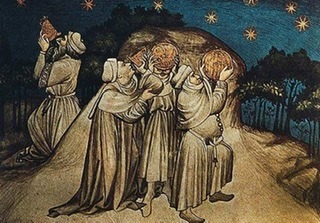
4242 BCE Egyptian calendar is one the first calenders in use, marking 12 months made of 30 days, with a year consisting of 360 days. 4000 BCE The basic concepts of astrology are first utilized in Mesopotamia. The Ziggurat at Uruk, Ur and Babylon, built by the Sumerians, are the first astrological observatories in the world, where early astrologers kept track of the Sun, the Moon and the five planets that they could see.
3000 BCE Egyptian calendar is revised to 365 days.
2872 BCE Sargon of Akkad, the first ruler of the Akkadian empire, is one the first to use astrologer priests to predict the future.
1200 BCE The Babylonians invent the written first systematic astrological system over thousands of years. The records survive in the form of the Babylonian star catalogs, making Babylonian astrology the oldest astrological system on Earth.
One of the earliest compilations is the Enūma Anu Enlil; meaning “When the Gods Anu and Enlil…” It is composed of approximately 70 astrological tablets, which include around 7000 predictions. The Babylonian astrological system was very omen-oriented, and such records were kept to predict the state of the king and the nation as a whole.
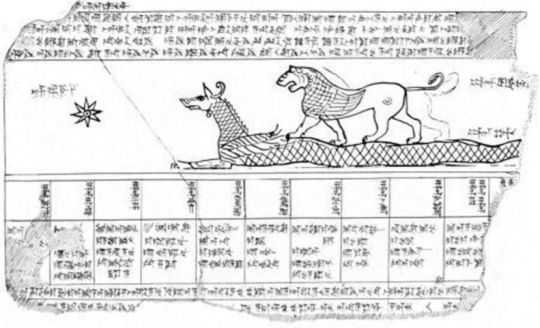
1000 BCE The MUL.APIN, was compiled, which consisted of the most significant star lists in Babylonian astrology. It contained 71 stars and constellations as well as their rising and setting times. The stars were also associated with specific deities. The Babylonians originally listed 17-18 constellations, but in later revisions, the number of constellations was reduced to 12 major ones. Many believe copies of the tablets carried astrology from Babylon to India, sometime between 400 and 300 BCE.
Babylonians recognized five planets—Jupiter associated with God Marduk, Venus with Goddess Ishtar, Saturn with Ninurta, Mercury with Nabu and Mars with Nergal.
The 12 Babylonian Astrological Signs
GU.AN.NA – Heavenly Bull, The Bull of Heaven (Taurus)
MASH.TA.BA – Twins, The Great Twins (Gemini)
AL.LUL – Pincers, Crayfish (Cancer)
UR.GU.LA – Lion, The Lion (Leo)
AB.SIN – Daughter of Sin, The Seed-Furrow (Virgo)
ZI.BA.AN.NA or GISH.ERIN – Heavenly Fate, The Scales (Libra)
GIR.TAB – That Which Claws And Cuts, The Scorpion (Scorpio)
PA.BIL.SAG – Defender, The Overseer (Sagittarius)
SUHUR.MASH – Goat-Fish, The Goat-Fish (Capricorn)
GU.LA – Lord Of Waters, The Great One (Aquarius)
SIM.MAH – Fishes, The Tails, Swallow Tail (Pisces)
LU.HUNG.GA – Field Worker (Aries)

700 BCE The present day zodiac wheel was shaped by the wheel that the Babylonians created
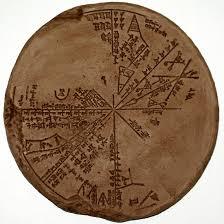
549 BC Cyrus the Great, the Achaemenid king of Persia, conquered Babylon.
572-490 B.C.E. Pythagoras, a Greek philosopher and mathematician, identifies the wisdom embodied within numbers, and theorizes that numbers are important to the universe, and they come together in harmony to create the world that we see. He was one of the first to refer to the universe as the Cosmos. His ideas were the foundation for the Pythagorean Theorem. His theory solidified the mathematics and science behind the planetary aspects that are used today. His ideas influenced some of the greatest philosophers in history.
535 BCE Pythagoras sets up a colony to learn about astrology, numerology and the occult arts - the Brotherhood.
475 BCE. Empedocles replaces the theory of matter with the theory that all of the substances derive from the four elements: fire, air, water and earth - which are the basic principles of developing astrological interpretations used today. He theorized that nothing can be created or destroyed, only transformed.
428-348 BCE. Plato's Timeus (360 BCE) identifies the universe as a living entity, composed of four elements (air, fire, water, earth) which distinguish each form by their molecular structure, although all four elements are interconnected and interrelated in a perfect harmonious form.
460 BCE. Hippocrates used earlier astrological and universal principles laid before him, and applied them to the study of the human body in relation to the rhythms observed within the universe as a whole.
409 BCE The oldest known horoscope chart is created
370 BCE Eudoxus of Cnidus invented a model of twenty-seven concentric spheres by which he was able to calculate the sun's annual motions through the zodiac, the moon's motion including its wobble, and the retrograde motions of the planets (27 Spheres, one for the fixed stars, three each for the Sun and Moon and four for each of the five planets). He created calendars using the zodiac with all 12 equal zodiac signs.
331 BCE Alexander the Great conquers Babylon and establishes the city of Alexandria. Under his rule, the Greeks further advances in astrology, along with developments in medicine, geometry, mathematics, and philosophy - furthering on the theories put forth by Pythagoras, Plato, Hippocrates, and Aristotle.
330 B.C.E. Berossus a Babylonian/Chaldean astrologer founds the School of Astrology at the Island of Cos. Many Greek astrologers learned and taught there.
330 BCE Alexander the Great spreads the knowledge of astrology throughout the Middle East. Greece personalizes astrology. The word astrology itself is derived from the Greek word for "star," and the word zodiac which means “the circle of animals.” The Greeks borrowed some of their myths from the Babylonians and invented many of their own, such as adding the names of their heroes to the constellations. The animals representing the signs were placed among the stars usually for great acts of heroism, and were usually associated with the Greek gods. The Greek words were translated to the Latin words that are used today.
290 BCE The legendary Alexandria becomes the center of astrological research. 250 BCE Achinapolus and Antipatrus teach medical astrology based on the teachings of Berossus. They begin to experiment with natal horoscopes.
207 BCE Galen, a Greek physician, combines the teachings of Plato, Aristotle, and Hippocrates, building upon them to create a functional system, for human anatomy and medical theories. He built upon Hippocrates earlier theory, that health requires an equilibrium between the four main bodily fluids, or humours—blood, yellow bile, black bile, and phlegm. Each of the humours is built up from the four elements and displays two of the four primary qualities: hot, cold, wet, and dry. He was one of the first to argue that humoral imbalances can be located in specific organs, as well as in the body as a whole. This modification of the theory allowed doctors to make more precise diagnoses and to prescribe specific remedies to restore the body’s balance.
200 BCE Astrology for predicting the future appears in Rome.

Papyrus with Greek Horoscope of Anubion Son of Psansnos , 2nd century CE, from Thebes, Egypt, Musée du Louvre, Paris, Département des Antiquités égyptiennes
100 BCE The Essenes develop the Qabbalah and esoteric astrology.
60 BCE First school of astrology opens in Rome.
7 BCE The birth of Christ is predicted by three Magi astrologers, using a star. 150 CE Ptolemy, a Greek astrologer and mathematician published the Tetrabiblos, which was one of the most revered astrology works ever written. The Tetrabiblos contained the core techniques of astrology including planets, zodiac signs, houses, and aspects, which are still relevant and heavily used today. 400 CE The Library of Alexandria containing many of the world’s texts on astrology is destroyed.
474 CE European astrology in decline after the Fall of the Roman Empire. 600 CE The Church condemns astrology and tries to suppress it. 639 CE Egypt is invaded and taken over by the Islamic Empire. This marks the end of the Hellenistic astrological tradition. 750 CE Muslim astrologers revive Greek astrology.
787-886 CE Arabic astrologer Abu Ma‘shar al-Balkhi writes the Kitab al-Madkhal al-kabir ila ‘ilm ahkam al-nujum (The Great Introduction). This was one of the most comprehensive astrology books written, that detailed scientifically, the astral influences on the material world, and the human body and life. The Great Introduction was translated into Latin first by John of Seville in 1133 CE.
801-873 CE The book De radiis stellicis (On the Stellar Rays) is written by Ya‘qub ibn Ishaq al-Kindi, which further combines Galen’s work, with Arabic astronomy, setting a precedent for medical treatments using astrology.
~ 1000 CE. Majriti (pseudo name) composes the Ghayat al-Hakim (The Picatrix), whose fundamental objective is to teach its reader how to determine the appropriate astrological time to contact celestial spirits and then “draw down” their essence by inducing them into a talisman created with materials which are sympathetic/resonate to, that particular spirit.

A page from the Picatrix
~1000 CE. Ibn Yunis, Moslem astronomer, compiles the Hakamite tables of planetary motions at Cairo.
1020 CE. Firdausi, or Abul-Qasim Mansur, Persia's epic poet, writes the Sah-Namah of over 60,000 couplets, containing many astrological references.
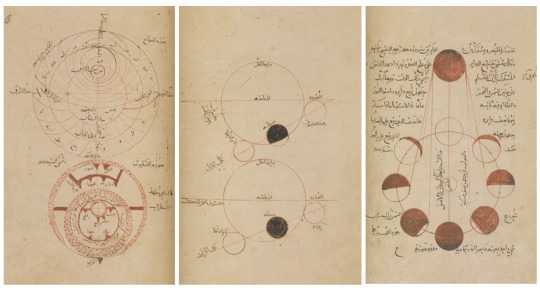
Kitāb al-tafhīm li-awā’īl ṣinā‘at al-tanjīm, Biruni, 11th century
~1114-1187 CE. Gerard of Cremona translates the Crises and the Critical Days from Arabic to Latin, allowing these great works to influence the educational climate of the time.
1200 CE The University of Bologna that was established in 1088 CE, becomes the center for learning medical astrology.
~1240-1311 CE. Arnald of Villanova wrote De iudiciis astronomiae, in which he wrote an influential treatise on the application of astrology to medicine. He combined Arabic teachings with Galen’s Critical Days, and used them to determine many methods of treating patients.
1250 CE Ancient magic and astrology is linked in the Speculum Astronomiae by Roger Bacon.
1255 CE Astrology is taught at Cambridge University in England. During this time Astrology is considered a science of the higher class, and many royals had court astrologers, and relied on them for predictions and medical advice. 1280 CE Johannes Campanus, an Italian astrologer and physician works for Pope Urban IV and develops a new way to divide astrological houses. ~1300 CE Almanacs (calenders) that contained star charts were employed by physicians, which allowed them to check the positions of the stars before making diagnoses. The book contained diagrams of the the body, and its corresponding star sign.
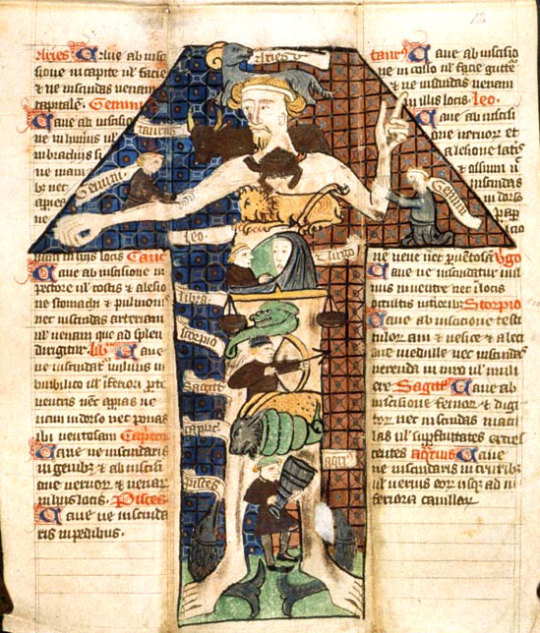
1399 CE Almanac diagram of the ‘Zodiac Man’

Diagram from a 1486 CE Medical Almanac
1400 CE The printing press is invented which allows mass production of astrological writings to be distributed in Europe. The Vatican promotes the instruction of astrology, with many Popes that were astrologers, and many served royal families in England, Italy, France and Austria.
1555 CE Andrew Dygges publishes A Prognostication, Manuscript on Medical Astrology in London, which became widely used by physicians. It attributed the zodiac signs to the specific body parts and organs of the human body, usually depicted visually.
~1500s CE All over Europe, physicians were required by law to calculate the position of the moon before carrying out complicated medical procedures.

1603-1668 CE Placidus, a monk and mathematics professor, created the house division system used by astrologers today.
The renaissance period, marks the period of enlightenment, and ushers in a decline in the use of astrology as a science.

Solar Zodiologium – prognostications when the sun is in each of the signs of the zodiac. The writer offers advice related to daily life and health, matters that would readers would find useful in either the 15th century or the 21st.
4 notes
·
View notes
Text
References
Babylonian Astrology
Budge, E.A Wallis. “The Babylonian Legends of Creation.” Sacred Texts, Department of Egyptian and Assyrian Antiquities, British Museum, 1921, www.sacred-texts.com/ane/blc/blc16.htm.
Quinn, Abbeygale. “Ancient Astrology - the Babylonian Zodiac - by Abbeygale Quinn.” Unified Astrology, 15 Dec. 2019, unifiedastrology.com/babylonian-zodiac/.
Rogers, J. H. Origins of the ancient constellations: II. The Mediterranean traditions. Journal of the British Astronomical Association, vol.108, no.2, p.79-89
Greek Astrology
Hays, Jeffrey. “Ancient Greek Astrology, Divinition, Omens, and the Zodiac.” Facts and Details, factsanddetails.com/world/cat56/sub405/item2026.html#chapter-6.
Karasavvas, Theodoros. “The 4,000 Year History of Horoscopes: How Astrology Has Been Shaped Throughout the the Millennia.” Ancient Origins, Ancient Origins, 9 Apr. 2017, www.ancient-origins.net/history-ancient-traditions/4000-year-history-horoscopes-how-astrology-has-been-shaped-throughout-021321.
Nutton, Vivian. “Galen.” Encyclopædia Britannica, Encyclopædia Britannica, Inc., 1 Jan. 2020, www.britannica.com/biography/Galen.
Ohlhausen, R.L., and Benik. “Greek Names of the Zodiac Signs: Greek Astronomy.” Greek Names, 30 July 2018, www.greek-names.info/greek-names-of-the-zodiac-signs/.
“Timeline Related to Greek Astronomy.” Hellenica World , www.hellenicaworld.com/Greece/Science/en/TLAstronomy.html.
Arabic Astrology
Casulleras, Josep P., and Jan P. Hogendijk. “Progressions, Rays and Houses in Medieval Islamic Astrology: A Mathematical Classification1.” Spanish Ministry of Science and Innovation , 2012, pp. 33–102., https://www.raco.cat/index.php/Suhayl/article/download/267220/354777/.
Lewis, James R. The Astrology Book: the Encyclopedia of Heavenly Influences. Bisible Ink Press, 2003. p 1-5.
Luminet, Jean-Pierre. “Ulugh Beg, Prince of Stars.” Ulugh Beg, Prince of Stars, https://arxiv.org/pdf/1804.08352.pdf.
Saif, Liana. “The Arabic Theory of Astral Influences in Early Modern Medicine.” Renaissance Studies, vol. 25, no. 5, 2011, pp. 609–626., doi:10.1111/j.1477-4658.2011.00742.x.
Shah, Nadiya. “The Picatrix .” Nadiya Shah, University of Kent , 10 Jan. 2017, nadiyashah.com/the-picatrix/.
Medieval Astrology
Duchan, Judith Felson. “Astrology and Medicine in Medieval Times.” Judy Duchan's History of Speech - Language Pathology, www.acsu.buffalo.edu/~duchan/new_history/middle_ages/astrology_and_medicine.html.
Dygges, Andrew. A Prognostication, Manuscript on Medical Astrology, London. 1555.
“Medieval Astrology.” The British Library - The British Library, Http://Www.bl.uk/Copyrightstatement.html, 19 May 2006, www.bl.uk/learning/cult/bodies/astrology/astrologyhome.html.
“Medieval Zodiac Chart.” The British Library - The British Library, www.bl.uk/learning/timeline/item107717.html.
Astrology Timeline
“Astrology Timeline.” Astrology by Luna, www.astrologybyluna.com/astrology-timeline.html.
“History of Astrology .” History World, www.historyworld.net/wrldhis/plaintexthistories.asp?historyid=ac32.
“History of Astrology: Spindle in Time, the Timeline.” Indigo Ray Astrology , 2003, www.indigoray.net/timeline.html.
Purcell, Victor. Humanistic-Existential Astrology: Principles and Evolution. Writers Club Press, 2000.
“Timeline of Ancient Astrologers.” The Hellenistic Astrology Website, www.hellenisticastrology.com/articles/timeline-of-ancient-astrologers/.
2 notes
·
View notes